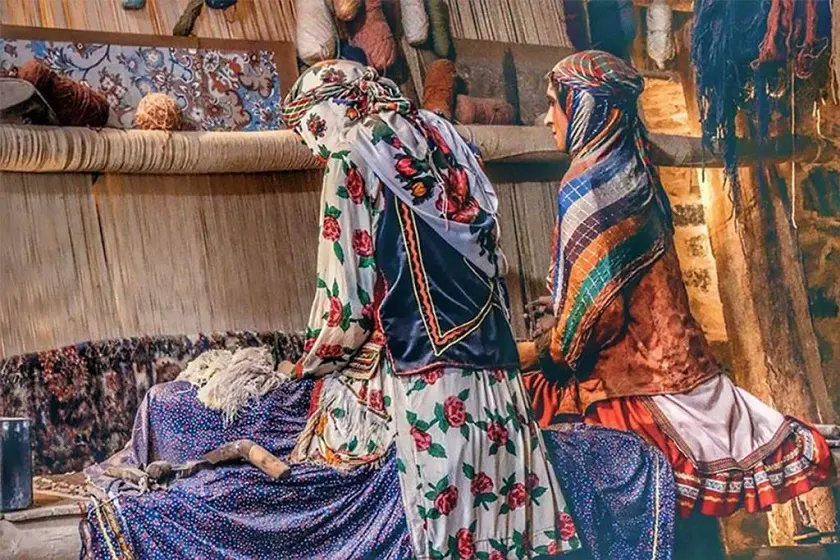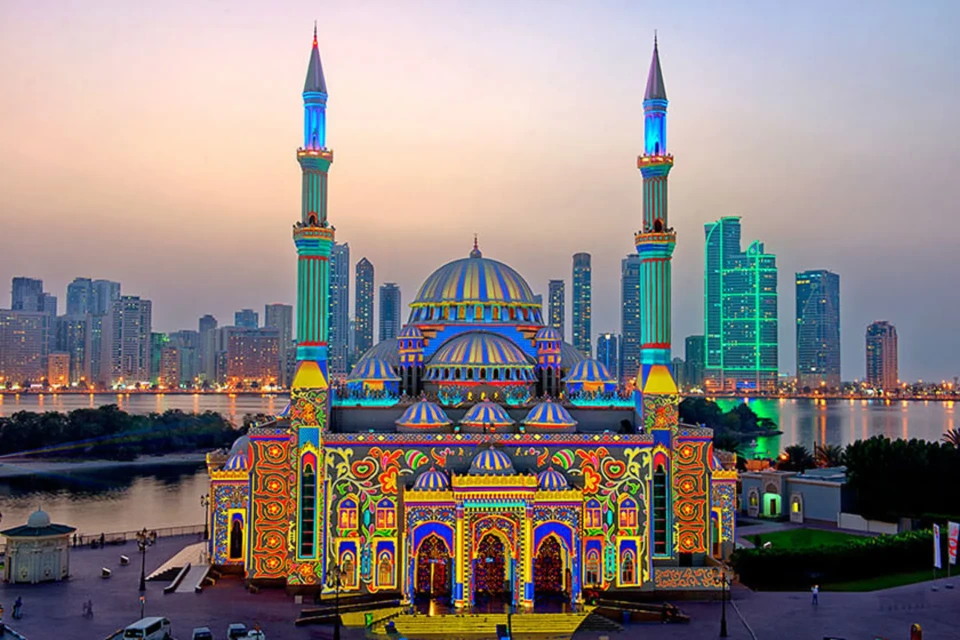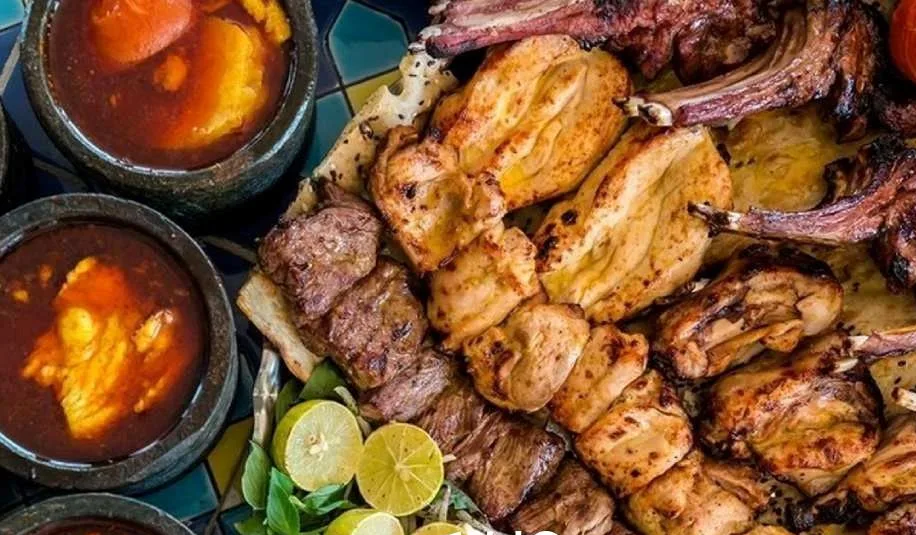Iranian carpet : From the history of Iranian carpet to its price
Iranian carpets, known as “Persian rugs,” embody the richness of Iranian culture, authenticity, and art. This ancient art has been preserved through the skill of hand-weavers and has been cherished within the vibrant Iranian culture throughout the ages.
Carpet weaving is one of the oldest and most authentic arts among Iranians. The world’s oldest carpet, believed to be of Iranian origin, dates back to the Achaemenid period. Importantly, this art continues to gain popularity internationally and among diverse cultures, thanks to its inherent authenticity and historical significance. The beauty of design and patterns plays a crucial role in the longevity of this art, with Iranian artists transforming Persian carpets into exceptional masterpieces by adhering to aesthetic principles in the central design and borders of the carpets.
Iranians have always shown a preference for using handmade carpets in their homes, aiming to enhance the beauty and warmth of their living spaces with this unique art. Iranian carpets come in various types, and understanding them aids in making the right choices when purchasing. This article seeks to familiarize you with this authentic Iranian art by introducing the best Iranian carpets, their types, and various patterns.

History of Iranian Carpets
Iranian carpets symbolize art, brilliance, culture, and authenticity. Iranians have been pioneers in carpet weaving, refining this art over time with precision, creativity, and taste, making it a hallmark of Iranian culture and art. The earliest documented evidence of Iranian carpet art can be found in Chinese texts related to the Sasanian era (224-641 AD).
Historical evidence indicates that the use of carpets was widespread since the Achaemenid period. It is essential to note that the primary materials used in carpets, such as wool, silk, cotton, etc., tend to deteriorate over time, making it challenging for archaeologists and historians to accurately determine the antiquity of carpets. Nevertheless, historical documents indicate the existence of magnificent carpets in the Achaemenid court, and it is said that Alexander the Great was amazed and impressed by the splendid Iranian carpets in Pasargadae. During the Seljuk and Ilkhanid dynasties, carpet weaving flourished as a valuable art and lucrative trade, with mosques of that era adorned with valuable Iranian carpets.
This rich history reflects the enduring legacy of Iranian carpet weaving, a testament to the artistry, craftsmanship, and cultural significance that continues to captivate admirers worldwide.
Pazyrk Carpet: The Oldest Carpet in the World
The oldest carpet in the world is called the Pazyrk carpet, discovered by a Russian archaeologist in the frozen tomb of a Scythian ruler between 1947 and 1949. Due to its discovery location in the Pazyrk Valley, Russia, it was named the Pazyrk carpet. Alongside this carpet, other ancient artifacts were also found. The Pazyrk carpet is made of wool and has a square shape, with each side measuring 1.98 meters.
This carpet is adorned with a floral border and depictions of horse riders, grazing deer, and mythical creatures with eagle heads and lion bodies. The discoverer, Sergei Rudenko, noted significant similarities between the motifs on this carpet and the prominent reliefs of Persepolis. While most researchers attribute this carpet to the Parthian or Medean periods, there are still different theories about its true antiquity. The Pazyrk carpet is currently preserved in the Hermitage Museum in Saint Petersburg.
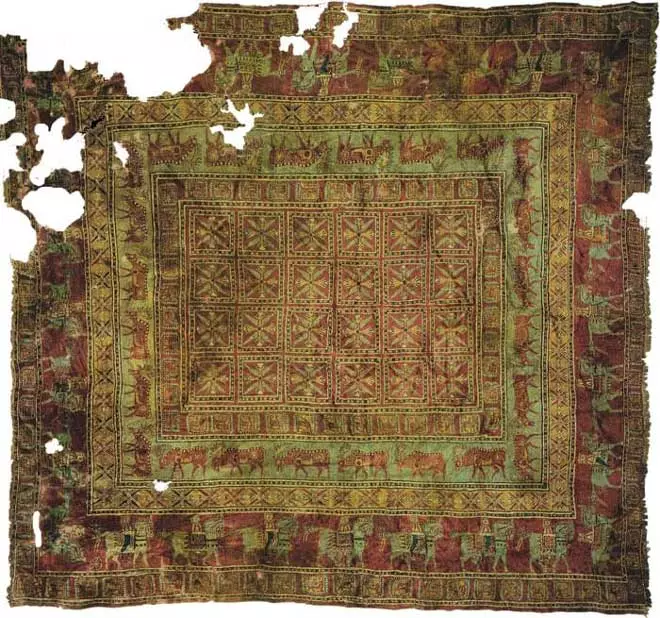
Authentic Iranian Carpets
Gabbeh: Natural Fiber Enthusiasts’ Choice
Gabbeh is one of the types of Iranian handmade carpets, known for its thicker and coarser texture compared to other Iranian carpets. What sets Gabbeh apart is the use of natural wool and plant-based dyes in its weaving.
Gelim: A Choice for Connoisseurs
Gelim is a type of flat-woven rug without pile, often woven with natural wool. Geometric patterns such as diamonds, hexagons, squares, and triangles are commonly used in Gelim, and natural and animal motifs are also incorporated. The weaving process includes spinning, dyeing, knotting, and chain weaving.
Jajim: An Authentic Handwoven Craft
Jajim is considered a flat-woven textile, crafted in long lengths with minimal width. It has a delicate and softer texture compared to Gelim. Jajim is woven in various regions, each named differently by its inhabitants. For example, in Ilam, it is referred to as “Joul.”
This overview showcases the diversity and richness of Iranian carpet weaving, highlighting the historical significance of the Pazyrk carpet as the world’s oldest known carpet.
Carpets from Northern Regions of Iran; Unique Designs
Regions such as Roudbar, Kelardasht, and Bandar Turkmen are known for producing carpets with triangular patterns. Dark red is predominant in most Turkmen carpets.
Tabriz Carpets; Among the Finest Iranian Carpets
The art of carpet weaving in Tabriz dates back to the Safavid era, and Tabriz carpets are known for their fine craftsmanship. The primary materials used in Tabriz carpets are often silk or wool. Characteristics of Tabriz carpets include:
Fine craftsmanship with high knot counts.
Short pile in Tabriz carpets is common.
Visually, these carpets exhibit depth, owing to the use of the light-and-shadow technique in their weaving.
Kashan Carpets
Kashan carpets typically have a medium pile height, and they are finely woven and delicate. While traditional color schemes were characterized by vibrant and contrasting colors, contemporary Kashan carpets incorporate softer colors based on customer preferences. Common patterns in Kashan carpets are a combination of decorative motifs. Color palettes usually include ivory, gray, brown, and tobacco hues.

Qom Carpets; Weaving Elegance
Carpet weaving initially thrived among the Qom nomads and rural communities but gradually gained popularity across the province due to its commercial significance. Qom carpets were initially woven with coarser threads but evolved into extremely fine and intricate pieces. The precision and order in Qom carpets may lead observers to question whether they are machine-made due to their refined nature.
Popular patterns in Qom carpets include the Shah Abbas medallion, forbidden fruit motifs, mihrab designs, and hunting scenes. The color palette has expanded over time, now featuring more than 40 diverse and distinct colors.
Most Popular Handwoven Carpets in Iran: Qom, Tabriz, and Kashan
Common designs in Qom carpets include Shah Abbas medallion, forbidden fruit motifs, mihrab designs, and hunting scenes. The color palette has expanded over time, now featuring more than 40 diverse and distinct colors. While Tabriz, Kashan, and Qom are considered the most popular handwoven carpets in Iran, personal preferences based on the characteristics and your taste will determine which region’s carpets are best for you.
Patterns of Iranian Carpets
If we aim to provide a comprehensive classification of Iranian carpet patterns, we can refer to the following categorization:
- Ancient and Islamic Art Patterns
- Shah Abbasi Patterns
- Islamic Patterns
- Inspired Patterns
- Boteh Patterns
- Afshan Patterns
- Boteh Jaqqa Patterns
- Turkmen Patterns
- Tree Patterns
- Farang Flower Patterns
- Hunting Scene Patterns
- Brick Patterns
- Fish Patterns
- Vase Patterns
- Geometric Patterns
- Mahramat Patterns
- Mehrabi Patterns
- Composite Patterns
- Tribal Patterns
- Symbols of Iranian Carpets
Understanding the symbols and motifs of Iranian carpets can provide a clearer insight into this art form for the audience. Below, we introduce some of the common symbols in Iranian carpets:
Eight-Pointed Star (Gol Taki): Represents courage and toughness, associated with people living in the mountains. Originally symbolizes mountain goats.
Diamond Pattern (Naghash Gereh): In the East, it signifies religion and is often depicted with extended rays outward.
Ram’s Horn (Ghooch): Represents a ram and is woven in two forms – one with the entire ram’s body and the other with the ram’s horns and branches. Predominantly found in Turkmen carpets, it holds great importance for Turkmen weavers.

Bird Pattern (Parandeh): Common and popular among weavers and audiences alike. Birds, especially the Simurgh, convey a special meaning and charm to Iranian carpets.
It’s essential to note that while some symbols, like the eight-pointed star and diamond patterns, have specific meanings, others may vary in interpretation. These symbols contribute to the richness and storytelling aspect of Iranian carpets, creating a visual tapestry that transcends mere decoration.
Bolourdi Tree Pattern: A Unique Symbol of Shiraz
The Bolourdi Tree pattern is one of the distinctive symbols of Shiraz. Although traditionally associated with Shiraz, in recent years, it has gained attention and usage in other regions of Iran. The Bolourdi Village is located at the foothills of the southwestern mountains of Shiraz. This symbol signifies strength, resilience, shade, and humility.
Swastika Symbol: A Timeless Iranian Motif
The Swastika symbol, also known as the Aryanic Sun, is one of the oldest patterns in Iran. In Iran, it symbolizes happiness and well-being. This symbol, with its curved and twisted arms, predates the Achaemenid period, and over time, its lines and geometric shapes have evolved. Some experts consider the Aryanic Sun as the origin and inspiration for many other designs and symbols.
Please note that the Swastika symbol in the Iranian context should be understood in its cultural and historical context, and it is distinct from its later association with negative connotations in other parts of the world.
The Best Iranian Carpets: Considerations for Choosing Quality Carpets
The answer to the question of which city produces the best carpets in Iran largely depends on your criteria for selecting a carpet. Iranians have showcased their skills, artistry, taste, and expertise in carpet and rug weaving for centuries. Among various regions, some have excelled more in the art of carpet weaving. Historical texts and documents indicate that villagers and nomads have been pioneers in carpet and rug weaving in Iran, and this art has gradually gained attention from other segments of society. Generally, carpets from Tabriz, Qom, Kashan, and the northern regions of Iran are considered the most popular Iranian carpets. However, aside from personal criteria for choosing and purchasing carpets, it’s essential to consider the following factors:
Carpet Material:
Pay attention to the material of the carpet, the type of piles, pattern, and color. This can assist you in selecting a high-quality carpet. If you intend to buy machine-made carpets, pay attention to the smell of the carpet, the transparency of colors, and the adhesion level. If the chosen carpet doesn’t emit a plastic smell, its material allows you to easily run your hand over it, and its colors and patterns are clear, then you’ve made a good choice, and the carpet is likely made of acrylic. Acrylic carpets are more resistant to environmental factors.
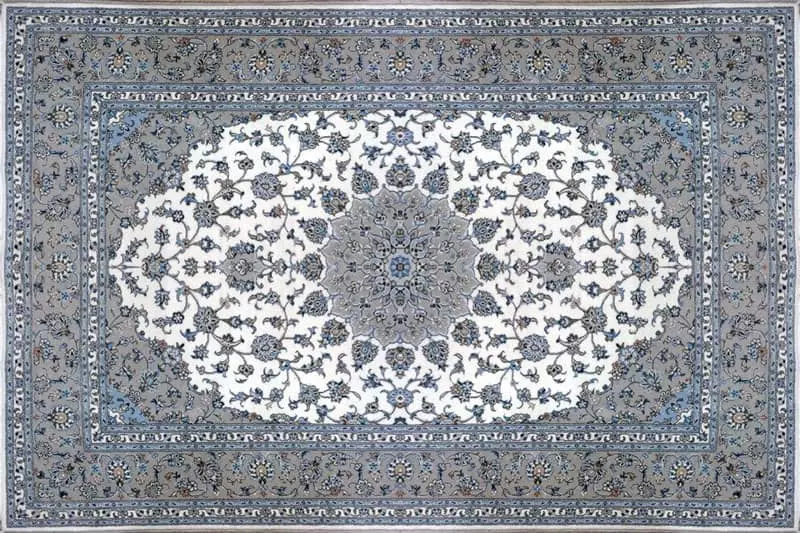
Number of Knots:
Pay attention to the number of knots per square inch. Knot density is crucial in determining the quality of a carpet. The transverse density is determined by counting the knots across the width, and the longitudinal density is determined by counting the knots along the length. Generally, the higher the knot density, the denser the weave and, consequently, the stronger the carpet.
Serial Number, Warranty, and Guarantee:
When purchasing carpets, especially machine-made ones, pay attention to the serial number, a valid warranty, and the guarantee certificate. Being attentive to these aspects can protect you from unscrupulous individuals who might offer low-quality carpets instead of authentic ones.
Carpet Size:
Pay attention to the size of handwoven carpets. While natural variations in size are acceptable, excessive deviations may be considered a flaw. When buying handwoven carpets, make sure to check symmetry by folding the carpet and aligning its edges to ensure balance.
Carpet Piles:
Carpet piles are essential factors in carpet quality. Soft piles that are not easily tangled and have clear colors and patterns indicate a good choice. Additionally, consider that soft piles are more resistant to environmental factors.
Back of the Carpet:
Do not just focus on the front of the carpet. A key factor that may be overlooked when buying a carpet is inspecting the back of the carpet. If a carpet is rotten or frayed, its value and credibility are diminished. Examine the back of the carpet for signs of fraying, such as needle damage, and listen for a light cracking sound similar to the sound of breaking when folding.
In summary, careful consideration of these factors will guide you towards selecting a high-quality and authentic Iranian carpet that suits your preferences.
Iranian Carpet Prices
The price of carpets varies based on multiple factors, and some of these factors are discussed below.
Handwoven vs. Machine-made:
One of the significant factors affecting carpet prices is whether the carpet is handwoven or machine-made. Handwoven carpets, being among the oldest and most authentic, hold both material and spiritual value. Purchasing handwoven carpets usually requires a higher investment compared to machine-made ones. The primary materials for weaving carpets are wool, silk, and cotton. In machine-made carpets, a certain percentage of synthetic materials may be added for cost adjustment, potentially affecting the quality and price of the carpet.
Pattern Consistency and Color Variation:
Discrepancies in the consistency of patterns or slight differences in colors and shades in different parts of the carpet contribute to reduced value and price, particularly in handwoven carpets.
Floral Design Integrity and Size:
Breakage of floral patterns or irregularities in the size of floral elements significantly determines the price of a carpet. Detecting such issues requires experience and expertise.
Pattern Complexity:
Some people consider the complexity of the carpet’s pattern and design as an essential factor in determining its price. There’s a belief that more intricate patterns contribute to higher value.
Determining the Age of Carpets:
Related Article: Where is the Carpet Museum in Iran?
To determine the age and lifespan of handwoven carpets, specific criteria are established. The term “new carpet” refers to carpets woven within the last five years. Carpets woven between 5 to 25 years ago are termed “old,” while those woven 25 to 60 years ago are referred to as “semi-antique.” Carpets woven between 60 to 250 years ago are categorized as “antique.”
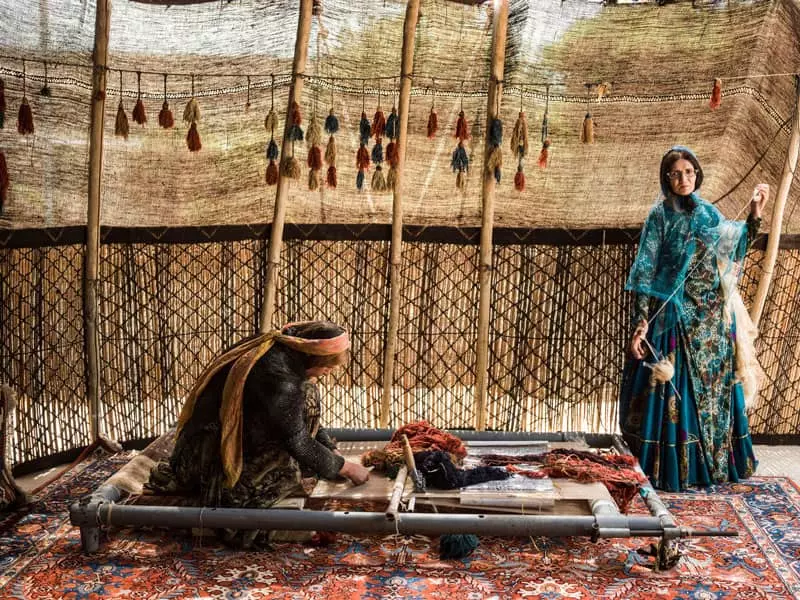
Proper Carpet Maintenance:
To prevent premature wear and increase the longevity of carpets, consider the following:
Avoid excessive heat in the storage area, as it can attract harmful insects and cause damage to the carpet.
Do not place carpets in direct sunlight, as even high-quality and authentic materials may lose their resistance to natural elements such as direct sunlight, wind, and water.
Always vacuum carpets in the direction of their pile.
When moving carpets, roll them instead of folding to reduce the risk of breakage.
Feel free to share your experiences or knowledge about Iranian carpet art with us and other users.
Frequently Asked Questions:
Since which historical period has the use of carpets been prevalent in Iranian culture?
Historical evidence suggests that the use of carpets has been prevalent since the Achaemenid period.
What is the name of the world’s oldest carpet?
The world’s oldest carpet is known as the Pazyryk carpet, discovered in the frozen tomb of a Scythian nobleman by a Russian archaeologist between 1949 and 1951.
In which cities are the most popular handwoven carpets produced in Iran?
The cities of Qom, Tabriz, and Kashan are known for producing the most popular handwoven Iranian carpets.
What factors should be considered when buying a carpet?
Material type, number of knots per square inch, serial number, warranty, carpet size, carpet piles, and examining the back of the carpet.

